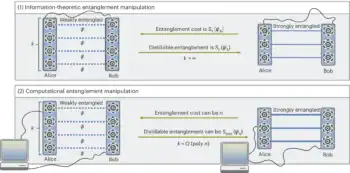
Researchers have observed quasiparticles in a classical system at room temperature for the first time, challenging the view that quasiparticles can only exist in quantum matter. The discovery, made in a thin fluidic channel containing flowing microparticles, suggests that the basic concepts of quantum matter physics might be applicable to classical settings.
The particles in many solids and liquids find themselves very close to each other and therefore strongly interact. This makes such “many-body” systems, as they are called, difficult to study and understand. In 1941 the Soviet physicist Lev Landau put forward a solution to this complicated situation: instead of considering the complex idea of strongly interacting particles, why not instead think instead about the excitations of the system?
“If these excitations are localized and rarely collide with each other, we can consider them as weakly interacting ‘effective particles’, or quasiparticles,” explains Tsvi Tlusty of the Institute for Basic Science (IBS) in Korea, who led the new study. “Landau’s conceptual breakthrough has been immensely useful in quantum matter research, providing insight into many emergent phenomena, such as electron-pairing in superconductivity and superfluidity, and recently electron flow in graphene.”
Too many collisions
Until now, quasiparticles have only been considered as quantum-mechanical objects. In classical condensed matter, the collision rate of excitations is typically much too high to allow for long-lived particle-like excitations. “Our findings are a breakthrough because, in contrast to this paradigm, we observed ‘Dirac quasiparticles’ in a classical hydrodynamic system,” Tlusty tells Physics World.
In the new work, Tlusty together with colleague Hyuk Kyu Pak and student Imran Saeed studied ensembles of microparticles driven by water flow in a very thin microfluidic channel. The researchers found that the motion of the particles perturbs the streamlines of the water flow surrounding them. The particles thus induce hydrodynamic forces on each other.
“Anti-Newtonian” particles
“Peculiarly, the forces between two particles are ‘anti-Newtonian’ – that is, they are equal in magnitude and direction in contrast to Newton’s law, which states that the mutual forces should oppose each other,” explains Tlusty. “The immediate consequence of this symmetry is the emergence of stable pairs that flow together at the same velocity.”
The result implies that the pairs are classical quasiparticles, or long-lived excitations in the hydrodynamic system. The researchers confirmed their hypothesis by analysing the vibrations (or phonons) in hydrodynamic two-dimensional crystals containing a periodic array of thousands of particles. They found that the phonons exhibit “Dirac cones”, much like those observed in graphene (a sheet of carbon just one atom thick) in which pairs of particles emerge.
Dirac cones are quantum features in the electronic band structure of a 2D material where the conduction and valence bands meet in a single point at the Fermi level. The bands approach this point in a linear way, which means that the effective kinetic energies of the conduction electrons (and holes) are directly proportional to their momenta. This unusual relationship is normally only seen for photons, which are massless, because the energies of electrons and other particles of matter at non-relativistic velocities usually depend on the square of their momenta. The result is that the electrons in Dirac cones behave as though they are relativistic particles with no rest mass, travelling through the material at extremely high speeds.
Strongly correlated flat bands
The IBS team also observed “flat bands” – another quantum phenomenon in which the electron energy spectrum contains ultra-slow phonons that are correlated extremely strongly. Flat bands were recently discovered in bilayers of graphene twisted with respect to each other at a certain angle. These bands are electron states in which there is no relationship between the electrons’ energy and velocity and they are especially interesting for physicists because electrons become “dispersionless” in them – that is, their kinetic energy is suppressed. As the electrons slow down almost to a stop, their effective mass approaches infinity, leading to exotic topological phenomena as well as strongly correlated states of matter associated with high-temperature superconductivity, magnetism and other quantum properties of solids.
“Our results suggest that emergent collective phenomena – like quasiparticles and strongly correlated flat bands – that so far were thought to be limited to quantum systems may be observed in classical settings, such as chemical systems and even living matter,” says Tlusty. “Perhaps these phenomena are much more common that we realized before.”

Half-light, half-matter quasiparticle appears in a van der Waals magnet
Such phenomena may help to explain various complex processes in classical systems too, he adds. “In this work, detailed in Nature Physics, we explain the non-equilibrium melting transition in the hydrodynamic crystal we studied as being the result of ‘quasiparticle avalanches’. These occur when the pairs of quasiparticles propagating though the crystal stimulates the creation of other pairs through a chain reaction.
“The quasiparticles pairs travel faster than the speed of phonons and thus every pair leaves behind an avalanche of newly-formed pairs – rather like the Mach cone generated behind a supersonic jet plane. Finally, all those pairs collide with each other, which eventually leads to the crystal melting.”
The researchers say there should be many more examples of quantum-like phenomena in other classical systems. “I feel that our findings are only the tip of the iceberg,” says Tlusty. “Revealing such phenomena may be very useful in advancing the understanding of emergent modes and phase transitions.”



